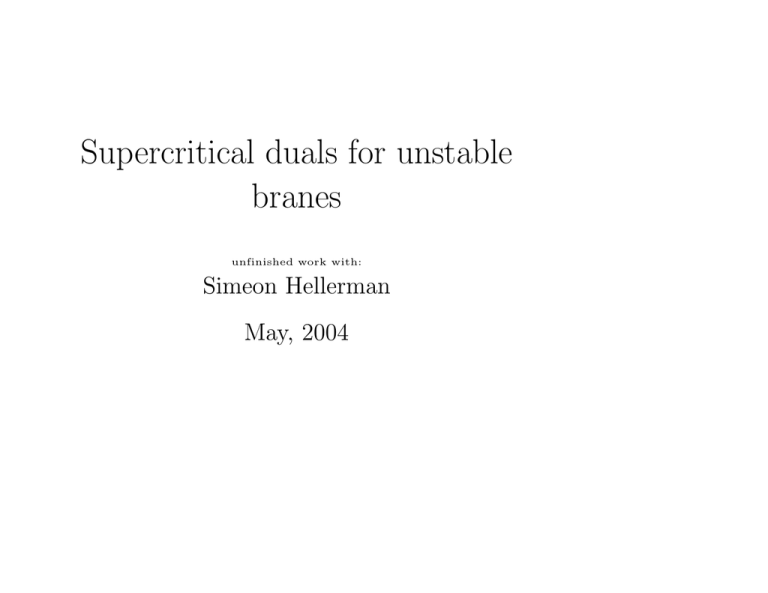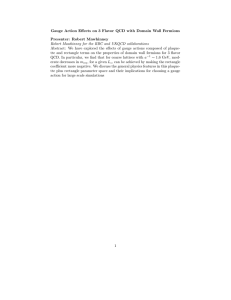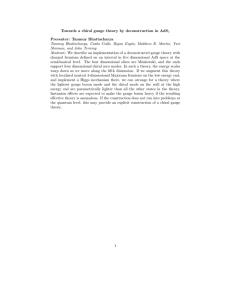Supercritical duals for unstable branes Simeon Hellerman May, 2004
advertisement

Supercritical duals for unstable branes unfinished work with: Simeon Hellerman May, 2004 Motivation String theory does not require D = 26 or D̂ = 10, even perturbatively. Our prejudices about Lorentz invariance do. D 6= 26 =⇒ tree-level dilaton tadpole. In principle, ∃ many ways to solve this. (e.g. large positive spacetime curvature, asymmetric orientifolds with RR flux...) If you force me to pick one, I will focus alas on the timelike linear dilaton CFT perhaps resolved by a Liouville wall. Spontaneously breaks lorentz invariance, still gauge invariant. We’ve learned a lot about −2 ≤ cmatter ≤ 1. ˆ ≡ 10.) (Attach hats where appropriate, 26 For 1 < cmatter < 25, Liouville is confusing cmatter > 25 is better-behaved. (∆ ∈ C..) How do supercritical strings fit into the duality web? The batman picture has few points labelled, most with Nsusy 1. a start towards “off-shell duality”: map the action of large gauge transformations on the configuration space. supercritical vacuum unstable brane S critical vacuum critical vacuum (At least, both sides exist at weak coupling and are interesting). A worldsheet description of Hull’s “NS9-branes” (or at least N S9 − N S9), whose existence was previously motivated by a central charge in the spacetime SUSY algebra, and by S-duality. Outline 1. Strategy 2. Tadpoleonic type O 3. Supercritical bosonic strings 4. type I – heterotic 5. D1-D9-D9 system in IIB Precedent for our strategy In general the weakly-coupled degrees of freedom on one side of an S-duality arise as ’solitons’ on the other. Many refs omitted. Q: when is a charged D-string ’fundamental’ ? 1. The basic example: IIB – IIB The type IIB D-string is a charged, stable non-perturbative string. Charged under RR 2-form C. S-duality: Φ ↔ −Φ, C ↔ B, Gstring ↔ eΦ Gstring . µν µν ls2 gs Its tension is that of the dual F-string. At strong coupling, it becomes light. The worldvolume theory is a two-dimensional gauge theory, asymptotically free gY2 M = gs µ−2 . At low energies, the gauge symmetry confines, the D-string has the same worldsheet spectrum as a long IIB (GS) F-string. Low-energy ↔ strong coupling. D-string probes provide linear sigma models (more generally, UV definitions) for the dual F-string worldsheet theory. (e.g. strings at K3, CY, G2 singularities, lattice models of the worldsheet) 2. type I – heterotic (Dabholkar, Hull, Polchinski-Witten) The SO(32) heterotic string is the type I D-string. Relative to type IIB: – Ω projection kills S+ – There are 1-9 strings. Their massless states are fermions λ+ from the R ground state with 8 ND directions which are chiral on the D-string worldsheet (+) because of GSO. Unoriented strings =⇒ the 1-9 fermions λa+ are real, in the 32 of the 9-brane gauge group. The worldvolume gauge group on the D-string – does not decouple – is Z2 , λ → −λ. =⇒ GSO projection on current algebra fermions. 3. type O = type I/(−1)Fs = type ∅B/Ω. (to be distinguished from type ∅A/B) O9 + O9 + 32 D9 + 32 D9 =⇒ (2,6,10) no tadpoles. Spectrum: bulk tachyon, two sets of CRR , and from the 9-9 open-strings, SO(32) × SO(32) gauge fields with open-string tachyons in the (32, 32). no perturbative fermions. (2) ) in type O There is a D-string (charged under one of the CRR whose worldsheet spectrum is that of the bosonic string on the SO(32) × SO(32)/Z2 lattice. (Bergman-Gaberdiel) There are both + and − chirality fermions from 1-9 and 1-9̄ strings. The Z2 is a diagonal GSO projection, from the D-string gauge group. BG propose that this provides the F-string worldsheet for a dual weakly-coupled closed-string description. (and that the other D-string becomes heavy at strong coupling.) The spectrum of this bosonic string again contains SO(32) × SO(32) gauge symmetry with a bifundamental tachyon. Again, the dual description of the gauge symmetry arises from worldsheet current algebra. ∃ still a frightening neutral tachyon on both sides. Strategy: Add D9-D9 pairs to these theories with D-strings. easiest on the worldsheet: tadpoleonic type O Now consider adding N extra spacefilling brane-antibrane pairs. The open-string gauge group becomes SO(32 + N ) × SO(32 + N ), the open-string tachyon is in the (32 + N, 32 + N). Disk-level dilaton tadpole (no RR tadpole). Consider again a D-string probe. the worldsheet spectrum consists of 10Xs as before, and no Ss plus 32 + N majorana spinors λa=1..32+N ± with Z2 worldvolume gauge symmetry λa± → −λa± . this is a free CFT with cL = cR = 26 + N/2. This is the F-string worldsheet theory of a bosonic string on the SO(32 + N ) × SO(32 + N )/Z2 lattice. The fluctuations of long D-strings can be quantized in a way which preserves SO(32 + N ) × SO(32 + N ) × SO(9, 1) (Polchinski-Strominger). But for short strings, conformal anomaly =⇒ tree-level dilaton tadpole upon coupling to worldsheet gravity. One way that the background fields near the D1 can solve this problem is ... bosonic strings in the timelike linear dilaton BG [Myers, de Alwis-Polchinski-Schimmrigk, Polchinski, Antoniadis-Bachas et al, Chamseddine] Consider the timelike linear dilaton background Φ(X 0 ) = QX 0 : T++ 32+N X 1 0 µ ν 2 = (∂+ X ∂+ X ηµν + Q∂+ X + λa+ ∂+ λa+ 2 a=1 with Q chosen so that 26 = c0 + 25 + N/2 (c0 = 1 − 6Q2 .) the mass-shell condition is 0 = k 2 + ikµ Qµ + m2 = (k + iQ)2 + Q2 + m2 In an effective spacetime action, the origin of this is clear: −2Φ(x) 2 L=e (∂µ T ) + V (T ) + ... EOM for T has a ∂µ Φ∂ µ T breaks lorentz invariance. −→ the k · Q term spontaneously Because Φ couples to worldsheet curvature, the spectrum on a cylinder can still be put into SO(9, 1) reps. Longitudinal modes still decouple: the vacuum energy of the X 0 boson compensates that of the current algebra to keep L0 − 1 = 0 as the physical state condition. Vertex operators have a factor of gs : e.g. ik·X QX 0 ik·X V (k) = gs (X)e = g0 e e 0 The factor of eQX is just the wavefunction in an expanding universe 2Φ 2 D−2 (einstein frame metric is ds = e ηµν dxµ dxν ) Fluctuations around this background do not grow. in this particular supercritical theory diagonal GSO: λ± → λ± Vertex operators for charged states are V (T, k) = λa+ λb̃− gs eik·X Tab̃ (k), k 2 = −1/2 2 V (AL , k) = λa+ λb+ ∂− X µ gs eik·X Aab µ (k), k = 0, similarly for L ↔ R, + ↔ −, a ↔ ã. Spectrum: bulk tachyon, BN S , gµν , Φ G = SO(32 + N ) × SO(32 + N )/Z2 with a charged tachyon in the (32 + N, 32 + N). as for the open-string theory. ˜ Also: massless bi-adjoints λa+ λb+ λc̃− λd− gs eik·X , k 2 = 0. These are Narain moduli. This lattice is a critical point of the potential generated by perturbative string interactions. (Ginsparg-Vafa) tachyons On the open-string side, condensing the charged tachyon higgses the open-string gauge group and brings us back to (some radiation above) the closed-string vacuum. (Sen...) There is an obvious conjecture for the fate of the charged tachyon in this supercritical theory – it should decay to the relevant critical theory. From the worldsheet point of view, in the current algebra, the relevant operator λa+ λb̃− Tab̃ (X) is just a (X-dependent) mass for the λs. To get some perspective, consider N = 2n even. the SO(2n) × SO(2n) level 1 current algebra can be bosonized abelianly: Pair λs into complex fermions, i = 1..n = N/2, λi+ =: e 26+i iX+ /2 :, X 26+i ≡ X 26+i + 2π this is the 26 + n-dimensional bosonic string on T n+16 with each circle at the free-fermion radius. From this viewpoint, the charged tachyons are KK modes of the 26 + n-dimensional bulk tachyon, λi+ λ†−ĩ =: eik26+i X 26+i : k26+i = 1 . 2 From this viewpoint, the above conjecture is a natural extension of popular lore about the closed bosonic tachyon. Defects The Higgs sector here is the same as on the worldvolume of the brane-antibrane system. One can consider solitons of the charged tachyon. It is possible to give a worldsheet argument for the fact that solitons of the tachyon carry charges of lower-dimensional branes predicted by S-duality. In the type O theory, there is a dead-leaf echo of IIB K-theory in the form of a coupling Z C6 ∧ (tr(F ∧ F )9 − tr(F ∧ F )9̄ ) where F are the field strengths of the SO(32 + N )9 × SO(32 + N )9̄ gauge fields, and C is one of the RR 6-form potentials. Recall that this characteristic class is sourced by the codimension four defect of the brane-antibrane tachyon. This suggests in the supercritical theory a coupling of the form Z S∼ B6 ∧ (tr(F ∧ F )L − tr(F ∧ F )R ) R10 where B6 is the field dB6 ≡ ?10 H3 to which an NS21-brane wrapped on T 16 couples electrically and FL,R are the field strengths of the SO(32 + N )L × SO(32 + N )R supercritical gauge fields. rewrite this as S∼ Z ?H3 ∧ (ωCS (A)L − ωCS (A)R ) This comes from the matrix element hVA (ζ1 , k1 )|VB (b, k2 )|VA (ζ2 , k2 )i where b is the polarization vector of the NSNS B-field. tadpoleonic type I an example with a stable vacuum under it: type I with n extra branes and antibranes G = SO(n) × SO(32 + n) open-string tachyon in the (n, 32 + n), 10d MW fermions in the (n+32)(n+32) ( n(n+1) , 1) ⊕ (1, )L ⊕ (n, n + 32)R . L 2 2 496 = n(n+1) 2 + (n+32)(n+31) 2 − n(n + 32) (Sugimoto, Schwarz-Witten) . Consider a D-string probe at x2 = x3 = · · · = x9 = 0. a 1-1 strings give X µ , S+ the spacetime modes of the heterotic string spectrum for any n. 1-9 type I strings give 2d MW fermions ã=1..n , λ λa=1..32+n + − the 9-9 gauge multiplet and real tachyon form a superconnection to which the D-string is coupled in Dirac notation ∂+ + A1 + X ? A9 T D= −T ∂− + A1 + X ? A9̄ iL = λ D λ as before, a long D-string can be quantized as an ’effective string’ preserving SO(32 + n) × SO(32) × SO(9, 1). but, for short strings, we need a description which is valid even when h∂Xi = 0. RNS? Our candidate superstring worldsheet lacks linearly-realized worldsheet supersymmetry. Even after using triality on the Ss, the lambdas are unpartnered. Q: How to give an RNS description, where N = 1 SCA is gauged? A: Dunno yet. Attempts a) Precurrents from the sky. e.g. Fermions ψ A (z) in the adjoint such that G(z)ψ A (0) ∼ like G(z)ψ µ (0) ∼ 1 A j (0) z 1 ∂X µ (z). z One could imagine that these arise as meson-like bound states of multiple 1-9 strings, when the D-string U (1) gauge group confines. or: the NS vacuum of a 1-9̄ string (massive, GSO even, bifundamental) has the right quantum numbers to be a worldsheet superpartner of λ should it become a massless – [see Hellerman 0405..., Q+ λa + = ∂+ X .] b) Nonlinear realizations. without introducing more fields, preservation of SU (N ) demands δ λi ∝ λi . G = GLR + g−1/2 λ† ∂λ + . . . T = T LR + λ† ∂λ, G(z)g−1/2 (0) ∼ 1/z who is the goldstino g−1/2 ? g should be thought of as the longitudinal mode of the worldsheet gravitino. i. B1 V1 strings: In realizing the bosonic string as an RNS superstring, the role of g−1/2 is played by c1 . (Berkovits,Vafa) , b1 , c1 are fermions with ∆ = 3/2, −1/2 =⇒ c = −11. G = GLR + b1 + c1 T N LR + twisting this is critical if cLR + cN LR = 26. with GLR = 0, this is the bosonic string. BV; Figueroa-O’Farrill; Ishikawa, Kato For various choices of GLR with only positive-norm fields, these theories seem to be consistent, unitary, not what we want. They have a bulk tachyon, c1 eikX . ii. we are breaking Lorentz symmetry with the linear dilaton vev. why not use ψ 0 to make g−1/2 . 1 T = (∂X)2 + Q∂ 2 X 0 + ψ∂ψ + λ∂λ 2 G = ψ∂X + Q∂ψ 0 + g−1/2 λ∂λ g−1/2 ∼ ψ 0 /∂X 0 Akulov-Volkov-Liouville ~+ ~ =ψ Q+ X ~+ = ∂+ X ~ Q+ ψ Q+ λã− = F ã Q+ F ã = ∂+ λã− Q+ g− = f + f −1 g− ∂+ g− Q+ X 0 = f −1 g− ∂+ X 0 Q+ λa+ = f −1 g− ∂+ λa+ 0 The object f (X 0 ) makes up conformal dimensions, f ∼ ebX −→ classically scale-invariant. The supercurrent looks like q.v. Berkovits-Vafa 1 −1 ~+ ·∂+ X+f ~ G(z) = ψ g− T N LR , T N LR ≡ λ+ ∂+ λ+ + ∂+ X 0 ∂+ X 0 2 1 Fixing unitary gauge for this supersymmetry ( g− , ψ+ = 0) gives the static-gauge D-string theory. the action is L= A −1 ~ ~ Q+ [µf g− + λA g− − F + ψ+ · ∂− X + f λa+ ∂− λa+ 0 0 + ∂+ X ∂− X ] A A A ~+ · ∂− ψ ~+ + ∂+ X ~ · ∂− X ~ + λA L = µ(f 2 + g− ∂+ g− ) − ψ − ∂+ λ− + F F +λ+ ∂− λ+ + ∂+ X 0 ∂− X 0 +f −2 0 0 0 0 g− ∂+ g− (λ+ ∂− λ+ + ∂+ X ∂− X ) − g− ∂− g− (λ+ ∂+ λ+ + ∂+ X ∂+ X ) the charged tachyon deformation is Q+ · [g− λã+ λa− Tãa (X)] SO(32 + n) gauge field: µ λa− λb− ] Q+ · [ψ+ SO(n) gauge field: Q+ · [f −1 g− λã+ λb̃+ ∂− X µ ] like in D = 2, changing µ can be undone by shifting the zeromode of the dilaton. The spectrum of bosons is then the same as the unstable type I theory. Observe that upon introducing the field redefinition 0 ψ+ = g− ∂+ X 0 f −1 (X 0 ) the supersymmetry variations 0 , Q+ X 0 = g− ∂+ X 0 f −1 (X 0 ) = ψ+ Q+ ψ 0 = ∂+ X 0 make X 0 , ψ 0 into a linear supersymmetry multiplet. Further, 0 0 . ∂− ψ+ f −2 g− ∂− g− ∂+ X 0 ∂+ X 0 = ψ+ Writing the f −2 g− ∂− g− λ+ ∂+ λ+ term in terms of ψ 0 requires inverse powers of ∂+ X 0 . When the charged tachyon is condensed, the extra lambdas are massive, and disappear in the IR, and our theory is identical to the linear theory of the usual SO(32) heterotic string. would like to check 496 = n(n+1) 2 + (n+32)(n+31) 2 − (n + 32)n. the D1-D9-D9 system in type IIB We would like to apply this logic in the IIB case, to understand the configuration space near the 10D SUSY IIB vacuum. Consider a D-string probe at x2 = x3 = · · · = x9 = 0. 1-1 strings give the type IIB F-string worldsheet spectrum as before. 1-9 type IIB strings make a massless complex fermion the 9-9 gauge multiplet and tachyon form a superconnection to which the D-string is coupled in Dirac notation ? ∂+ + A1 + X A9 T D= −T̄ ∂− + A1 + X ? A9̄ iL = λ† Dλ see also Sugimoto-Takahashi, 0403247 There is an anomaly in the axial U (1) symmetry λ± → e±iα λ± , (?) generated by j = (λ†+ λ+ , −λ†− λ− ). d ? j = [ch D]2 −→ tr F when A9 , T are flat. (on a flat worldsheet.) But this U (1) is part of the 9-brane gauge group. The anomaly is cancelled by inflow (Green-Harvey-Moore) . Even before we added the D-string probe, there was a coupling Z d10 x (∂χ + tr Arel )2 (Schwarz-Witten) and under the relative U (1), χ → χ + α, Arel → Arel − 1 dα. A A X + X j X X j The RR axion has a coupling Z χ tr F1 D1 so when it shifts as in (?) δχ = α it cancels the anomaly. consider the case N = 1. we have λ+ , λ− complex, altogether a Dirac fermion coupled to a U (1) gauge field iL ⊃ λ†+ (∂− + A− )λ+ + λ†− (∂+ + A+ )λ− This is the Schwinger model. massless when T = 0. We can bosonize the λ current: (j+ , j− ) ≡ (λ†+ λ+ , λ†− λ− ) ≡ (∂+ φ, ∂− φ) with φ ≡ φ + 2π, the free-fermion radius. the gauge symmetry acts by φ → φ + λ. Combined with the coupling to the RR axion R D1 χ F+− , this is Buscher’s path-integral derivation of T-duality: a. pick unitary gauge for the U (1): φ = 0. the integral over A induces 2d kinetic terms for χ with Rχ = 1/Rf f . re-fermionizing χ, we get a Dirac fermion with a non-chiral GSO projection. b. the path integral over χ gives a delta function imposing F+− = 0. Lorentz gauge ∂α Aα = 0 then gives the theory without any gauge symmetry. sum over windings of χ kills holonomies of A, too. (Rocek-Verlinde) In the N > 1 case, we can apply a similar argument to the U (1) ⊂ SO(2N ) current which is gauged. The effect of the worldvolume gauge symmetry is to project out SO(2N ) multiplets which are not U (N ) multiplets. =⇒ su(N )1 × u(1)R=√N current algebra. So: we want to find a IIB superstring with this worldsheet content which can be quantized preserving U (N ) × U (N ) × SO(9) it is again possible in this case to write a (1, 1) supersymmetric 0 action preserving SO(9) × U (N ) × U (N ), by using ψ± as a goldstino. Fields without superpartners again transform as Q+ λ− = f −1 g− ∂+ λ− ... From scale-invariant deformations of the action we find U (N ) × U (N ) gauge symmetry with a bifundamental tachyon. Unfortunately: complicated and hard to quantize. Instead: look at defects in the trivial background. take N = 2, pick four directions i = 1..4, and in the UV take T (X)ab̃ = 4 X σai b̃ X i i=1 this object, which couples as a mass for λ, has a kernel in codimension four, at X i = 0. In lightcone gauge, we can show the existence of the coupling Z B6 ∧ (tr(F ∧ F )L − tr(F ∧ F )R ) (the calculation can be reduced to the critical lightcone heterotic calculation). This shows that this codimension-four defect of the supercritical higgs sector carries NS5-brane charge. there should also be a one-loop term Z 4 4 B2 ∧ tr(F )L − tr(F )R (codim 8 defect carries F1 charge) some words about time-dependent tachyon condensation The physical tachyon vertex is a target-space-time-dependent mass for the extra matter λ. in its presence, the λ path integral is still gaussian: Z R − tr λ† Dλ [dλ] e = det D it should be possible to understand how the dilaton slope changes itself in response to the consumption of extra dimensions by the charged tachyon from the coupling to worldsheet curvature. though more complicated than the bosonic case, this (0, 1) theory has the distinct advantage that it condenses to a stable vacuuum. Kappa symmetric description Consider the usual d = 10 kappa-symmetric type IIB GS string worldsheet. Add N free Dirac fermions λ. Their kinetic terms couple to the worldsheet metric, which transforms under the kappa symmetry. But in two dimensions, an arbitrary infinitesimal change in the metric can be rewritten as a combination of a coordinate transformation and a weyl rescaling. Acting with such a transformation on the metric and the lambdas together, the action for λ is invariant. It is possible to impart upon the λs a kappa-transformation which renders their action invariant. other examples – type ∅B – the USp theory Sugimoto – type O-like theories with G = SO(32 + m) × SO(n) × SO(32 + m) × SO(n) with tachyons in the (32 + m, 1, 32 + m, 1), (1, n, 1, n) and massless fermions in the (32 + m, n, 1, 1), (32 + m, 1, 1, n), (1, n, 32 + m, 1), (1, 1, 32 + m, n) – the U(32) theory ? what about type IIA?? APS-like argument –UNDER CONSTRUCTION!! Back to the bosonic case for a moment. Try to follow the strategy employed by Adams-Polchinski-Silverstein to observe the fate of a closed-string tachyon: (Tune the neutral tachyon to zero in what follows.) Consider a D-brane probe. e.g. Spacefilling ⊗ WZW brane Identify the relevant operator on the worldvolume via which the CST couples. the supercritical gauge symmetry plays the role of the quantum symmetry. Identify the IR limit of the field theory upon perturbing by this operator. T couples like a mass for the open-string operators which move the brane around in the extra dimensions. Concluding comments – When is a charged, stable D-string ’fundamental’ ? – i.e. quantizable as a fundamental object? – A worldsheet perspective on NS-branes as regions of space where strings can propagate in more dimensions could be useful (classification of charges, hopefully something more dynamical). – Even if you fear for the utility of non-SUSY dualities, these are accessible excitations above the vacua, similar to unstable branes with instabilities that we can understand. – Making sense of the analogous worldsheets for topological strings could give some meaning to “NS2” and “NS5” branes in that context. – LSMs for worldsheets with H-flux?







